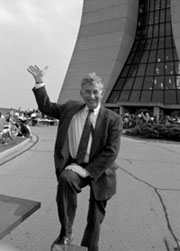 |

Parting Words Director John Peoples Bids Farewell. "We wanted to go after the top quark. That was the big thing." "I know that our physics will go on in a great way…. But don’t forget the woods, the beauty and the buildings." by Mike Perricone "Fermilab had been given a rare opportunity to go its own way." Director John Peoples sat quietly as his life and career at Fermilab were toasted and roasted at the June 10 symposium held in his honor, but then his turn came to reflect on the best of his 10 years at the Laboratory. With his party about to get started, and barbecue and sparkling grape juice awaiting guests in the atrium, Peoples promised to keep his remarks "down to eight hours." He launched into a narrative about the birth of the Recycler, and ended up paying his respects to the entire Fermilab staff. "It would be nice to get a few things down for history," he said. The Recycler was born, Peoples said, during the chaos that resulted from the termination of the Superconducting Super Collider. While he ended up being the SSC’s "funeral director (for reasons that I will someday write about)," his thoughts at the time, like those of the rest of the high-energy physics community, were on "what to do next." "We wanted to go after the top quark. That was the big thing," he said, but it would require a new machine, the Main Injector, and maybe even others. "We wanted to get the luminosity up in the Tevatron." During the week, he had to be down in Dallas, and sometimes out in Washington, Peoples said, but he would come back to Fermilab on weekends. "This is one example of how our staff is so fantastic," he said. He and key staff, including his assistant, Mary Cullen, would meet on Saturday mornings to plot the future. "We’d run a regular work day," Peoples said. At one of these meetings, Peoples recalled, Fermilab physicists Bill Foster and Gerry Jackson presented an idea for improving the Tevatron. Building on an innovation first contemplated by founding Director Bob Wilson, Foster proposed putting an 8-GeV storage ring in the Main Injector to increase the intensity of antiprotons, and hence the luminosity of the Tevatron. Like all brilliant ideas, Peoples said, this one was immediately dismissed as ridiculous. But Foster and Jackson persisted, eventually developing a concept for what came to be called the Recycler. Peoples said that, in the beginning, he was probably more enthusiastic about the Recycler than Steve Holmes, project manager for the Main Injector, but that was understandable. In shutting down the SSC, Peoples was dealing with a budget of a billion dollars. By comparison, $10 million for the Recycler seemed positively cheap. Holmes, however, was responsible for completing the Main Injector not only on time but on budget, and $10 million could very well break his bank. Peoples won DOE’s support by "peddling Ernie Malamud’s notion that it would be cheaper [to use Foster’s and Jackson’s permanent magnets] for an 8-GeV transfer line from the Booster to the Main Injector" than to use the standard dipoles. The construction of that leg of the accelerator complex, commissioned in record time, "was the critical point," Peoples said, convincing DOE and even Fermilab management that the Recycler, with its unprecedented ring of permanent magnets, would work. Foster’s and Jackson’s persistence paid off. And they did persist, even when those much-trumpeted permanent magnets turned out to have some "terrible temperature properties." Foster and Jackson "kept coming up with improvements," Peoples said. The birth and success of the Recycler, Peoples emphasized, "is typical of what goes on at Fermilab. When an idea comes up that’s practical, implementable, and affordable, it gets a lot of consideration." As it turned out, the Recycler wasn’t needed to find the top quark, he said, but "who knows what we will discover" with the new machine. Reflecting on other matters, Peoples commented that, "for reasons I don’t understand," from its inception, "Fermilab had been given a rare opportunity to go its own way." "Maybe it started with Wilson," he said. Glenn Seaborg, who headed the Atomic Energy Commission, probably recognized that "you either had Wilson build the lab he wanted, or you might as well get rid of him." And DOE, Peoples said, did not stand in the way: "As a consequence, we were all allowed to go off and design our own buildings." Of course, Wilson didn’t always approve the designs; he put his arm through the model of one proposed building he didn’t like. But still, Peoples said "we all got a chance at making the site organic and beautiful." Peoples said that when he recently escorted Dan Goldin, NASA administrator, on a tour of Fermilab, he told Goldin about "all the characters who had run this laboratory" and showed him the novel laboratory buildings, Goldin was impressed, remarking that "you couldn’t do this in the government today." Then, turning to his successor, Mike Witherell, who was sitting in the audience, Peoples said, "I hope, Mike, that you will continue to be one of the characters." And he enjoined Witherell to "keep the place beautiful." After all, he said, "the director is in charge of beauty." In fact, "the director is in charge of all kinds of interesting things in this place, including the woods." "I know that our physics will go on in a great way," Peoples said in closing, "and I’m confident that we will be blessed by great machines some day. "But don’t forget the woods, the beauty and the buildings." |
| last modified 7/2/1999 email Fermilab |
FRLsDFx9eyfrPXgV